Students must start practicing the questions from CBSE Sample Papers for Class 12 Biology with Solutions Set 11 are designed as per the revised syllabus.
CBSE Sample Papers for Class 12 Biology Set 11 with Solutions
Time : 3 Hours
Maximum Marks : 70
General Instructions:
- All questions are compulsory.
- The question paper has five sections and 33 questions. All questions are compulsory.
- Section-A has 16 questions of 1 mark each; Section-B has 5 questions of 2 marks each; Section-C has 7 questions of 3 marks each; Section-D has 2 case-based questions of 4 marks each; and Section-E has 3 questions of 5 marks each.
-
There is no overall choice. However, internal choices have been provided in some questions.
A student has to attempt only one of the alternatives in such questions. - Wherever necessary, neat and properly labelled diagrams should be drawn.
Section A
Question 1.
Many athletes take drug before playing sports to enhance their performance. Out of the options given below, select the correct drug that help the athlete to increase their energy?
(a) Opioids
(b) Cannabinoids
(c) Barbiturates
(d) Lysergic Acid Diethylamide (LSD)
Answer:
(b) Cannabinoids are the drugs often taken by atheletes to enhance their performance, as they bring about euphoria and excitement, (increased energy).
Question 2.
Which of the following contains the actual genetic part of a sperm?
(a) Head
(b) Tail
(c) Middle piece
(d) Whole of it
Answer:
(a) The head of the sperm is anterior, broad flattened and oval structure. It consists of two parts, i.e. posterior large nucleus and anterior small cap-like acrosome. The nucleus consists of condensed DNA and basic proteins. Thus, the head contains the actual genetic part of sperm.
Question 3.
A \(\stackrel{\oplus}{\longrightarrow}\) Population density \(\stackrel{\theta}{\longleftarrow}\) B.
If A increases population density and B decreases it then choose the correct option of A and B.
(a) A can be mortality which brings positive change in population density
(b) B can be emigration which brings negative change in population density
(c) values of A and B can never be equal
(d) Both (b) and (c)
Answer:
(d) Both options (b) and (c) are correct as ‘A can be natality and/or immigration (brings positive change in population density) and B’ can be mortality and/or emigration (brings negative change in population density). Values of A and B can never be equal. As at a given place and time, natality and mortality or immigration and emigration can never be equal.
Question 4.
The diversity in the type of finches and adaptation to different feeding habits on the Galapagos islands, as observed by Darwin, provides an evidence of
(a) origin of species by natural selection
(b) intraspecific variation
(c) intraspecific competition
(d) interspecific competition
Answer:
(a) The diversity in the type of finches and adaptation to different feeding habits on the Galapagos islands was observed by Darwin. He provided an evidence of origin of species by natural selection.
Question 5.
Which of the following is used as ‘clot buster’ for removing clots from blood vessels of patient who have undergone myocardial infarction?
(a) Ethanol
(b) Statins
(c) Cyclosporin-A
(d) Streptokinase
Answer:
(d) Streptokinase produced by the bacterium Streptococcus and modified by genetic engineering is used as a clot buster for removing clots from the blood vessels of patients who have undergone myocardial infarction leading to heart attack.
Question 6.
Pyramid of number is
(a) always upright
(b) always inverted
(c) either upright or inverted
(d) neither upright nor inverted
Answer:
(c) Pyramid of number shows the total number of individual organisms at each level in the food chain of ecosystem. The pyramid of number is always upright but can be inverted in a tree ecosystem.
Question 7.
Two different species cannot live for long duration in the same niche or habitat. This law is called as
(a) Allen’s law
(b) Gloger’s rule
(c) Weismann’s theory
(d) Competitive exclusion principle
Answer:
(d) Two or more species with closely similar niche
requirements cannot exist in the same area, sooner or later they come into competition for possession of it. This is called as Gause’s competitive exclusion principle.
Question 8.
Find out correct equations shown in the graph.
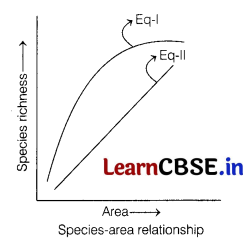
(a) I – S = CA
Z
; II – log S = log C + Z log A
(b) I – log S = log C + Z log A; II – S – CA
Z
(c) I – S = CA
Z
+ log C; II- log S = log C + Z log A
(d) I – S = CA
Z
; II – log S = log C + Z log A
Answer:
(a) Eq. I, S = CA
Z
Eq. II, logS = logC + Zlog A
Question 9.
Nucleosome consist of DNA sequence wrapped around core of histone proteins. The net electric charge on histones and DNA is
(a) Positive
(b) Negative
(c) Both (a) and (b)
(d) Zero
Answer:
(c) DNA consists of nitrogenous base, pentose sugar and a phosphate group. DNA has negative charge due to the presence of phosphate group \(\left(\mathrm{PO}_4^{3-}\right)\).
Histones are rich in the basic amino acid residues lysine and arginine, which carry positive charge in their side chains. Therefore histones are positively charged.
Question 10.
Which of the following conditions given in the table below describes thalassemia?
| Conditions | Heterozygous | Dominant |
| (a) | Yes | Yes |
| (b) | No | No |
| (c) | Yes | No |
| (d) | No | Yes |
Answer:
(c) Thalassemia is an autosome linked recessive blood disease. It is transmitted from parents to offspring when both are the unaffected carrier for the gene, i.e. heterozygous.
Question 11.
HIV is a virus that attacks the body’s immune system. Identify the means of transmission and is it curable or not.
| Transmission | Curable | |
| (a) | Blood transfusion | Yes |
| (b) | Sneezing and Coughing | Yes |
| (c) | Blood transfusion | No |
| (d) | Sneezing and Coughing | No |
Answer:
(c) The HIV virus is spread through the blood transfusion or through physical contact. It is a non- curable disease.
Question 12.
The figure given below shows the changes that take place in the endometrium during a normal menstrual cycle.
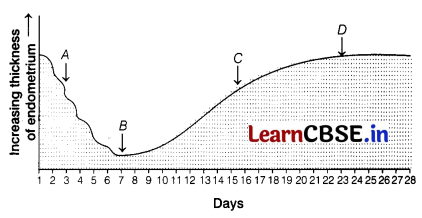
Which of the following alphabets shows the correct event?
| Ovulation | Menstruation | |
| (a) | C | A |
| (b) | A | B |
| (c) | B | C |
| (d) | B | D |
Answer:
(a) Menstruation occurs for 3 – 6 days, while an ovulation occurs on around 14th day of a normal menstrual cycle. Hence, the correct alphabets are C and A respectively for ovulation and menstruation.
Question Nos. 13 to 16 consist of two statements, Assertion (A) and Reason (R). Answer these questions selecting the appropriate option given below.
(a) Both Assertion and Reason are true and Reason is the correct explanation of Assertion
(b) Both Assertion and Reason are true, but Reason is not the correct explanation of Assertion
(c) Assertion is true, but Reason is false
(d) Assertion is false, but Reason is true
Question 13.
Assertion (A) : Sticky ends forms hydrogen bonds with their complementary counter parts.
Reason (R) : These are formed when the restriction enzyme cuts the DNA little away from the centre of the palindrome.
Answer:
(a) Both Assertion and Reason are true and Reason is the correct explanation of Assertion.
The sticky ends are the overhanging stretches on each strand of DNA. These are formed when the restriction enzyme cut DNA little away from the centre of the palindrome but between the same two base of opposite strands. The sticky ends thus, form the hydrogen bonds with their counterparts. Thus, facilitating the action of DNA ligase enzyme.
Question 14.
Assertion (A) : Nicotine, caffeine, quinine, strychnine and opium are produced by plants as defence against grazers and browsers.
Reason (R) : Thorns of Acacia and cactus are most common physiological means of defence.
Answer:
(c) Assertion is true, but Reason is false.
Nicotine, caffeine, quinine, strychnine and opium are produced by plants as defences against grazers and browsers. Thorns of Acacia and cactus are most common morphological means of defence.
Question 15.
Assertion (A) : All biodiversity hotspots if put together, cover less than 2% of the earth’s land area.
Reason (R) : The strict protection of the hotspots could reduce the ongoing mass extinction by almost 2%.
Answer:
(c) Assertion is true, but Reason is false.
All biodiversity hotspots if put together, cover less than 2% of the earth’s land area. The strict protection of the hotspots could reduce the ongoing mass extinction by almost 30%.
Question 16.
Assertion (A) : Intra cytoplasmic sperm injection (ICSI) is a procedure to form an embryo in vitro.
Reason (R) : In ICSI, sperm is directly injected into the ovum.
Answer:
(b) Both Assertion and Reason are true, but Reason is not the correct explanation of Assertion.
Intra Cytoplasmic Sperm Injection (ICSI) is a specialised procedure to form an embryo in the laboratory in which a sperm is directly injected into the ovum. Then, the embryo is transplanted into the uterus for further development.
Section B
Question 17.
Rahul’s parents brought a pet dog for him. But as soon as the dog entered the house, Rahul started complaining about having watery eyes along with running nose. After some time when Rahul was kept away from the pet, the symptoms disappeared. Name the type of antibody and the chemicals responsible for such a response in the boy. Also mention the name of any one drug that could be given to the boy for immediate relief from such a response.
Answer:
The symptoms watery eyes and running nose are observed in people suffering from allergy. It is a condition in which the immune system reacts to foreign substance.
The IgE antibodies are involved in the case of allergy.
The chemicals such as histamine and serotonin are responsible for such responses. For immediate relief antihistamine could be given in such situation.
Question 18.
The diagram below shows the sequence of base pair. Based on this answer the questions that follows
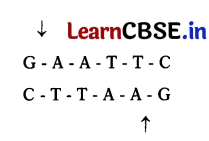
(i) The above sequence is recognised by which restriction enzyme?
(ii) What is the role of restriction enzyme?
Answer:
(i) The given nucleotide sequence is recognised by endonuclease restriction enzyme e.g. EcoRI.
(ii) A restriction enzyme is a protein isolated from bacteria that cleave DNA sequences at sequence – specific sites, producing DNA fragments with a known sequence at each end.
Question 19.
In the figure given below, the diagram of human sperm is shown. Study the figure and answer the questions that follows.
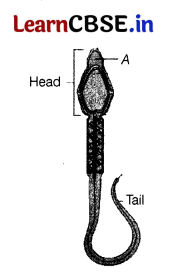
(i) Name the part labelled as A and state its significance.
(ii) State what will happen if a sperm fails to contact an ovum within a specific period?
Answer:
(i) ‘A ’ is acrosome. It contains hydrolytic enzymes and is used to contact and penetrate the egg (ovum) during fertilisation.
(ii) If a sperm fails to contact an ovum within a specific period, it exhausts its energy and dies.
Question 20.
Observe the global biodiversity distribution of the major plant taxa in the given diagram and answer the questions accordingly.
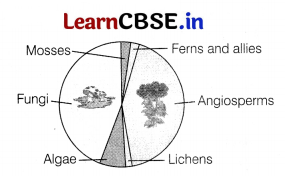
(i) Why are mosses/ferns so few? Give reason.
(ii) How do fungi that are heterotrophs sustain themselves as a large population?
Answer:
(i) Mosses and ferns are very few as they need humid conditions in forests and forests are disappearing.
(ii) Fungi are able to sustain themselves as a large population because of their wider adaptability to the changing environment conditions.
Question 21.
(i) Given below is a schematic representation of determination of sex.
Name the organisms in which this type of sex-determination method is seen.
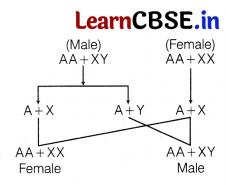
(ii) XX-XY type of sex-determination is an example of male heterogamety or female heterogamety? Justify your answer.
Or
Explain the phenomenon of multiple allelism taking ABO blood groups as an example. Given the phenotype for the following (a) I
A
i (b) ii.
Answer:
(i) This type of sex-determination method is seen in human and in insect like Drosophila melanogaster.
(ii) XX-XY type of sex-determination is an example of male heterogamety, because in this mechanism . the male produces two different types of gametes. While, female is homogametic with single type of chromosome (i.e. X-chromosome).
Or
Multiple Allelism A phenomenon in which gene exist in more than two allelic form or combinations For example, the gene for blood group exists in three allelic forms I
A
, I
B
and i.
The phenotypes of the following genotypes are
I
A
i – A blood group
Ii – O blood group
Section C
Question 22.
Study the figure of a lac operon given below.
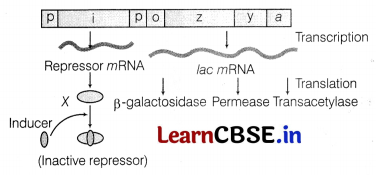
(i) Name the molecule X’ synthesised by i gene. How does this molecule get inactivated?
(ii) When will the transcription of this gene stop? which one of the structural genes code for (β-galactosidase?
Answer:
(i) Molecule X’ is a repressor protein. When an inducer combines with it, it is inactivated.
(ii) Transcription of gene stops when substrate (lactose) is not available and when energy source (glucose) is available to cells.
‘Z’ gene codes forp-galactosidase.
Question 23.
Explain labia majora, LH surge and blastocyst in relevance to human reproduction.
Answer:
(i) Labia majora are large, fleshy folds of tissue which extends down from the mons pubis and surround the vaginal opening.
(ii) LH surge The rapid secretion of LH leading to its maximum level during the mid cycle of menstruation is called LH surge. It induces rupture of Graafian follicle and release the ovum.
(iii) Blastocyst A hollow cellular mass formed during the early development consisting of cells forming the inner cell mass and the fluid-filled cavity or blastocoel is known as blastocyst.
Question 24.
Genetic disorder occur when a mutation affects your genes. Genes are made up of DNA, which contain instructions for cell functioning and the characteristics that make an individual unique. Carrying the mutation does not always mean that one will end up with a disease. But sometimes it can raise the risk of having a genetic disorder.
(i) A normal couple gave birth to one haemophilic son and two normal daughters. Work out the cross to show the genotypes of the parents and their progeny.
(ii) Give the possible genotypes of the parents, who can give birth to haemophilic daughters?
Answer:
(i) Haemophilia is an X- linked recessive disease. The gene responsible for haemophilia is located on X-chromosome.
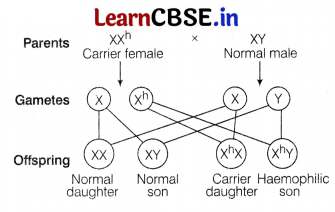
Here, one of the son is affected, this means that the mother is a carrier. As haemophilia show criss cross inheritance.
(ii) The genotypes of the parents, who can give birth to haemophilic daughters are X h Y and X h X.
Question 25.
(i) Identify A in the given figure and mention its function.
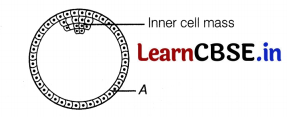
(ii) Name the stage of human embryo that is shown in the figure.
(iii) Mention the fate of the inner cell mass after implantation in the uterus. Where are the stem cells located in this embryo?
Answer:
(i) ‘A’ mentioned in the figure is trophoblast. It is the layer that gets attached to the endometrium of the uterus and later forms chorionic villi. Which gets inter digitated with the embryo.
(ii) The stage shown in the figure is blastocyst.
(iii) The inner cell mass gets differentiated into an embryo. The stem cells are found in the inner cell mass of the blastocyst.
Question 26.
Many secondary metabolites of plants have medicinal properties. It is their misuse that creates problems’. Justify the statement with an example.
Answer:
Many secondary metabolites obtained from plants are used for their medicinal properties, e.g. opiates derived from poppy plant such as morphine is a sedative, painkiller, etc.
Some other chemicals like barbiturates, amphetamines, benzodiazepines are used to treat depression and insomnia. As their effect occurs on thoughts, feeling and perception of a person.
But the problem arises when these metabolites are misused by taking their overdose, either to have pleasure, or for entertainment purpose, which easily get converted into addiction.
Excess closes of these drugs can lead to hallucination and can also damage CNS system. Once a person is addicted to drugs, they cannot survive without it. And in the absence of these, they suffer from withdrawal syndrome leading to anxiety, shakiness, nausea, etc.
Question 27.
Single species populations involve species of similar types interacting and interbreeding within their own population. These species not only interacts with their own types but with other species from different population also. These interactions or associations can negatively or positively affect the growth and development of the population. Rarely, the type of interaction is neutral, where two interacting species do not effect population growth. This type of interaction is designated as 0/0 affect in a two species system. Positive interactions are those where either both or only one interacting population is benefitted.
(i) Name and explain the type of inter action that exists in mycorrhiza.
(ii) Name and explain type of interaction that exists between cattle egret and grazing cattle.
Or
There are many animals that have become extinct in the wild but continue to be maintained in zoological parks.
(i) Which type of biodiversity conservation is observed in this case?
(ii) Explain any other two ways, which help in this type of conservation.
Answer:
(i) Mycorrhiza It is an association between fungi and roots of higher plants. This interaction is called mutualism. The fungi help plant in the absorption of essential nutrients from the soil, while in turn it provides the fungi with energy yielding carbohydrates. Both partners are benefitted.
(ii) The cattle egret and grazing cattle share commensalism type of relationship. The grazing cattle flush out insects from grass while grazing. So, it becomes easier for egret to catch and feed on them. In this, one partner gets benefit, while other remains unaffected.
Or
(i) It is an example of ex situ (offsite) conservation. In this approach, threatened plants and animals are taken out of their natural habitat and placed in suitable settings and given special care.
(ii) Cryopreservation and tissue culture are two ways that help in ex situ conservation.
(a) Cryopreservation It is a method of in vitro conservation in liquid-N2 at temperature of -196°C (-130°F) in a controlled rate freezer for vegetatively propagated crops and storing other biological materials.
(b) Tissue Culture Plant tissue culture is widely used to produce clones of a plant by a method known as micropropagation. This method is useful in maintaining a large number of genotypes in small area, rapid multiplication of even endangered species and for hybrid rescue, e.g. banana and potato.
Question 28.
State the functions of ori, rop and Hind III sites in the cloning vector pBR322.
Answer:
ori is a sequence of DNA from where replication starts. Any piece of DNA that needs to replicate in the host cell has to be linked to it.
rop in pBR322 encodes for protein involved in plasmid replication.
Hind III is a restriction site in pBR322, where Hind III endonuclease makes a cut for the introduction of foreign DNA segment.
Section D
Q. Nos. 29 and 30 are case-based questions. Each question has 3 subparts with internal choice in one subpart.
Question 29.
Study the cross given below and answer the questions that follows.
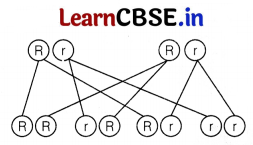
(i) On the basis of the above cross, what conclusion can you draw about the pattern of inheritance and disease? [1]
(ii) What is the percentage of the offsprings that are affected? [1]
(iii) If the affected offspring marries with an unaffected individual, what are the chances of their child to be affected? Explain. [2]
Or
(iii) In this type of inheritance pattern, out of male and female children, which one has less probability of receiving the trait from the parents. [2]
Answer:
(i) The cross given above is for thalassemia. It is an autosomal-linked recessive blood disorder transmitted from parents to the offspring when both the partners are unaffected carrier for the gene.
(ii) Only the homozygous individuals are affected, as it is an recessive disease, i.e. 25%.
(iii) Cross between the affected with an unaffected individual are as follows The unaffected individuals can be RR or Rr.
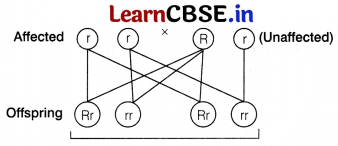
In this case, there is 50% chances of their child to be affected.
Or
(iii) As it is an autosomal disorder, both the male and female have equal probability of receiving the trait. This disease is due to either mutation or deletion, which results in reduced rate of synthesis of one of the globin chains (a and p) that makes haemoglobin. This causes formation of abnormal haemoglobin.
Question 30.
Study the graph given below and answer the questions that follows
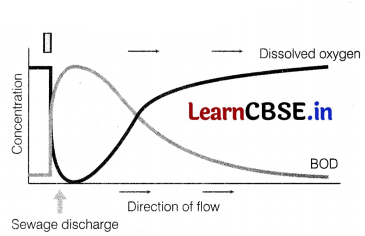
(i) What is the relationship between dissolved oxygen and biochemical oxygen demand? [2]
(ii) How will this affect aquatic life in river? [1]
(iii) Name the factors which affect dissolved oxygen. [1]
Or
(iii) Does the sewage treatment require aerobic conditions all through out? Justify your answer. [1]
Answer:
(i) Dissolved Oxygen, (DO) is the amount of oxygen dissolved in water bodies and it is measured in parts per million or ppm. Whereas, the amount of dissolved oxygen used by aerobic organisms to decompose the organic matter present in water sample is called BOD or Biochemical Oxygen Demand.
BOD and DO are inversely proportional to each other.
(ii) The greater the BOD, more rapidly oxygen is depleted in the stream. It means less oxygen is available for aquatic life forms. The high BOD and low DO lead to the suffocation of aquatic organisms and ultimately their death.
(iii) Dissolved oxygen is influenced by various factors such as temperature, and type of water body, etc.
Or
(iii) It is required only, during the secondary treatment, i.e. biological treatment because these microbes consume all the organic matter present in the effluent.
Section E
Question 31.
The table given below shows the different genotypes of human ABO blood types. After thoroughly examining the table, find the genotype and phenotype of the offsprings. Also explain the phenomenon associated with ABO blood groups.
| Allele from parent I | Allele from parent 2 | Genotype of offspring | Phenotype of offspring |
| I A | I A | – | – |
| I A | I B | – | – |
| I A | i | – | – |
| I B | I A | – | – |
| I B | I B | – | – |
| I B | i | – | – |
| i | i | – | – |
Or
Study the diagrammatic representation of the operation of natural selection on different traits.
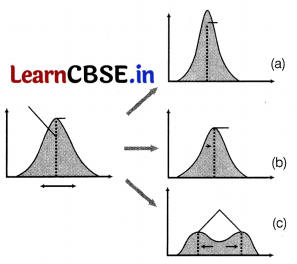
(i) Natural selection occurs due to the inheritance of variation, how different traits selection will affect the peak of graph?
(ii) A population is exhibiting genetic equilibrium’.
Regard to the above statement, name and explain the underlying principle.
(iii) In a population which has achieved Hardy-Weinberg equilibrium, which two processes will not occur? Justify.
Answer:
| Allele from parent I | Allele from parent 2 | Genotype of offspring | Phenotype of offspring |
| I A | I A | I A I A | A |
| I A | I B | I A I B | AB |
| I A | i | I A i | A |
| I B | I A | I B I A | AB |
| I B | I B | I B I B | B |
| I B | i | I B i | B |
| i | i | ii | O |
The phenomenon associated with blood group is codominance. In this phenomenon two alleles express themselves independently when present together in an organism. In other words, it is the phenomenon in which offspring shows resemblance to both the parents.
Or
(i) Depending upon the traits favoured, natural selection can have three effects on peak of graph,
(a) Stabilisation : Large number of individuals acquire mean character values, i.e. peak gets higher and narrower.
(b) Directional : Large number of individual acquire value other than mean character value, i.e. peak shifts in one direction.
(c) Disruption : Large number of individual acquire peripheral character value at both ends of curve, i.e. two peaks are formed.
(ii) The underlying principle is Hardy-Weinberg equilibrium, This states that the relative frequency of alleles of sexually reproducing organisms in a given population remains constant from generation to generation.
Sum total of all the allelic frequency is equal to 1. e.g. in a diploid, if p and q represent the frequency of an allele A and allele a. The frequency of AA individual in a population is p
2
, of aa is q
2
and of Aa is2pq.
Hence, it can be expressed as
p
2
+ 2pq + q
2
= 1
(iii) In such population natural selection and random
mating does not occur. This is because both these processes promote evolution which disrupts the Hardy-Weinberg equilibrium.
Question 32.
For cultural reasons modern contraception has been slower to gain acceptance in Ethiopia. Knowledge about contraception and abortion is limited as family and community settings as it is socially disapproved. By 2000 only 4% of Ethiopian females aged 15 – 49 used contraception. Little is known of Sexually Transmitted Disease (STD) prevalance in Family Planning (FP) attenders in Africa in general and Ethiopia in particular, even through attenders of Family Planning Clinics (FPCs) are appropriate target groups for epidemiological studies and control programmes.
(i) Name the complication that arises due to late detection of STDs.
(ii) Explain how STD can be prevented by self-consciousness?
(iii) Mention early symptoms of STDs.
Or
Hormone contraception refers to birth control methods that act on endocrine system. Almost all methods are composed of steroid hormone, although in India one selective oestrogen receptor is marketed as a contraceptive.
Pie chart of different types of hormonal contraceptives used by the females in India are given below.
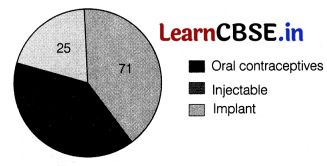
(i) Evaluate the usage of OCP in modern India.
(ii) Which of the method is least-adopted by females? Explain why?
(iii) From the above information suggest why injectable methods are not used more than OCP?
Answer:
(i) Late detection of STDs leads to infertility and often death.
(ii) STDs can be prevented by following these principles
(a) Avoid sex with multiple partners.
(b) Always use condoms during coitus.
(c) Use sterilised needles and syringes
(d) Awareness about STDs.
(iii) Early symptoms of STDs include itching, fluid discharge, slight pain and swelling in the genital region.
Or
(i) From the given data, it is clear that the use of oral contraceptive pills are more as compared to injectables and implants. As these pills are easy to take. They have to be taken daily for a period of 21 days starting within the first five days of menstrual cycle. After a gap of 7 days, it has to be repeated in the same pattern till the female desires to prevent contraception.
(ii) Implants are least adopted by females as compared to other hormonal contraceptives. Although, the implants are 99% effective but can cause headache, breastpain and nausea in the females.
(iii) Injectable methods are not used as much as OCP because oral contraceptives (like pills) can be taken by the female herself whereas for injectable female needs to visit the nurse.
Question 33.
Explain genetic engineering along with the steps involved in rDNA technology.
Or
List ten recombinant proteins which are used in medical practice? Find out where they are used as therapeutics.
Answer:
Genetic engineering is termed as the manipulation of genetic material in vitro. It involves the techniques to alter the chemistry of genetic material (DNA and RNA), to introduce the host organisms and thereby change the phenotype of the host organism.
Steps involved in /-DNA technology are
- Isolation of DNA.
- Fragmentation of DNA by restriction endonuclease.
- Amplification of gene of interest.
- Ligation of the DNA fragment into the vector using DNA ligase.
- Transfer of the recombinant DNA into the host.
- Culturing the host cell on a suitable medium on a large scale.
- Extraction of the desired product.
- Downstream processing of the products as finished products.
Or
Important recombinant proteins are as follows
- Human insulin for diabetes mellitus.
- Factor VIII for the treatment of haemophilia – A.
- Factor IX for the treatment of haemophilia – B.
- Erythroprotein for treating anaemia.
- Tissue plasminogen activator for dissolving blood clots.
- Hepatitis-B surface antigen to vaccinate against hepatitis – B.
- ReoPro in the prevention of blood clots.
- Platelet growth factor in stimulation of wound healing.
- Interferon alpha in the prevention of hepatitis – C.
- Hirudin as an anticoagulant.